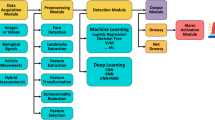Abstract
Transportation is playing a vital role in our daily life and its development has made many of our chores much easier. But in recent years, driver drowsiness, distractions, and speed limit crossing cause ruinous road accidents which lead to fatalities. Slumbering, dozing, alcohol consumption cause intrusiveness which needs to alert the driver before a mishap happens. In this paper, a prototype is designed using Raspberry Pi, Pi Camera, sensors for monitoring driver’s eye movements, detecting yawning, detecting toxic gases, and alcohol consumption to prevent accidents and provide safety assistance to drivers. Internet of Things and machine learning-enabled system is implemented in vehicles for transmitting the behavior of the driver and his driving pattern to the cloud to take quick response under emergency situations. Several lives are saved by alerting the driver with help of a sound system that is deemed to prevent any distractions before happen. The cloud services and machine learning are employed in identifying fatigue drivers through the collected and stored dataset from cloud services. The device is experimentally tested, and the results show its efficiency and effectiveness.





























Similar content being viewed by others
References
Lee BG et al (2015) Wristband-type driver vigilance monitoring system using smartwatch. IEEE Sens J 15(10):5624–5633
Hossain MY (2018) IoT based real-time drowsy driving detection system for the prevention of road accidents. ICIIBMS. https://doi.org/10.1109/iciibms.2018.8550026
Dada EG et al (2017) Alcohol detection of drunk drivers with automatic car engine locking system. Nova J Eng Appl Sci 6(1):1–15
Gopinath V (2017) Avoiding drunken driving road accidents by using alcoholic sensors. In: IJEAS, vol 4, Issue 5
Teyeb I et al (2016) Towards a smart car seat design for drowsiness detection based on pressure distribution of the driver’s body. In: ICSEA 2016: the eleventh international conference on software engineering advances
Reyes-Muñoz Angelica et al (2016) Integration of body sensor networks and vehicular ad-hoc networks for traffic safety. Sensors 16:107
Archa A et al (2019) IoT based driver drowsiness detection and traffic collision avoidance system using raspberry pi. In: International journal of engineering sciences & research technology NACETEC’ 19 ISSN: 2277-9655
Sharma S (2018) IoT based car accident detection and notification algorithm for general road accidents. In: IJECE, vol 9(5)
Vural E et al (2007) Machine learning systems for detecting driver drowsiness. In: Proceedings, digital signal processing for in-vehicle and mobile systems, Istanbul, Turkey
Jacobé C et al (2019) Detection and prediction of driver drowsiness using artificial neural network models. Accid Anal Prev 126:95–104
Gupta H (2019) An IoT based air pollution monitoring system. In: ICSETS, vol 7
Gromera M et al (2019) ECG sensor for detection of driver’s drowsiness. In: 23rd International conference on knowledge-based and intelligent information & engineering systems, Elsevier B.V. https://doi.org/10.1016/j.procs.2019.09.366
Anitha C et al (2016) A two fold expert system for yawning detection. In: 2nd International conference on intelligent computing, communication & convergence (ICCC-2016), Elsevier. https://doi.org/10.1016/j.procs.2016.07.324
Alvi U et al (2020) A comprehensive study on IoT based accident detection systems for smart vehicles, vol 8, IEEE Access. https://doi.org/10.1109/access.2020.3006887
Bhatti F et al (2019) A novel internet of things-enabled accident detection and reporting system for smart city environments. Sensors 19:2071. https://doi.org/10.3390/s19092071
Dashora Chirag et al (2019) IoT based framework for the detection of vehicle accident, Cluster Computing. Springer Nature, Berlin
Nanda S et al (2018) An IOT based smart system for accident prevention and detection. In: IEEE
Kumar KN et al (2019) Automatic accident rescue system using IoT. In: Springer Nature 2019, International conference on computer networks and communication technologies. https://doi.org/10.1007/978-981-10-8681-6_52
Zantalis F et al (2019) A review of machine learning and IoT in smart transportation. Future Internet 11:94. https://doi.org/10.3390/fi11040094
Coronato A, Paragliola G (2017) A structured approach for the designing of safe AAL applications. Expert Syst Appl. https://doi.org/10.1016/j.eswa.2017.04.058
Yea J et al (2011) Situation identification techniques in pervasive computing: a review. Pervas Mob Comput. https://doi.org/10.1016/j.pmcj.2011.01.004
Coronato A et al (2014) A situation-aware system for the detection of motion disorders of patients with Autism Spectrum Disorders. Expert Syst Appl Elsevier. https://doi.org/10.1016/j.eswa.2014.05.011
Duttagupta S et al (2016) Performance prediction of IoT application: an experimental analysis. In: IoT’16: Proceedings of the 6th international conference on the internet of things, pp 43–51. https://doi.org/10.1145/2991561.2991572
Banda G et al (2016) One IoT: an IoT protocol and framework for OEMs to make IoT-enabled devices forward compatible. J Reliable Intell Environ 2:131–144. https://doi.org/10.1007/s40860-016-0027-5
Kumar SAP et al (2018) A novel digital twin-centric approach for driver intention prediction and traffic congestion avoidance. J Reliab Intell Environ 4:199–209
Bacciu D et al (2017) On the need of machine learning as a service for the internet of things. In: IML ‘17: proceedings of the 1st international conference on internet of things and machine learning, vol 22, pp 1–8. https://doi.org/10.1145/3109761.3109783
Author information
Authors and Affiliations
Corresponding author
Additional information
Publisher's Note
Springer Nature remains neutral with regard to jurisdictional claims in published maps and institutional affiliations.
Rights and permissions
About this article
Cite this article
Uma, S., Eswari, R. Accident prevention and safety assistance using IOT and machine learning. J Reliable Intell Environ 8, 79–103 (2022). https://doi.org/10.1007/s40860-021-00136-3
Received:
Accepted:
Published:
Issue Date:
DOI: https://doi.org/10.1007/s40860-021-00136-3




